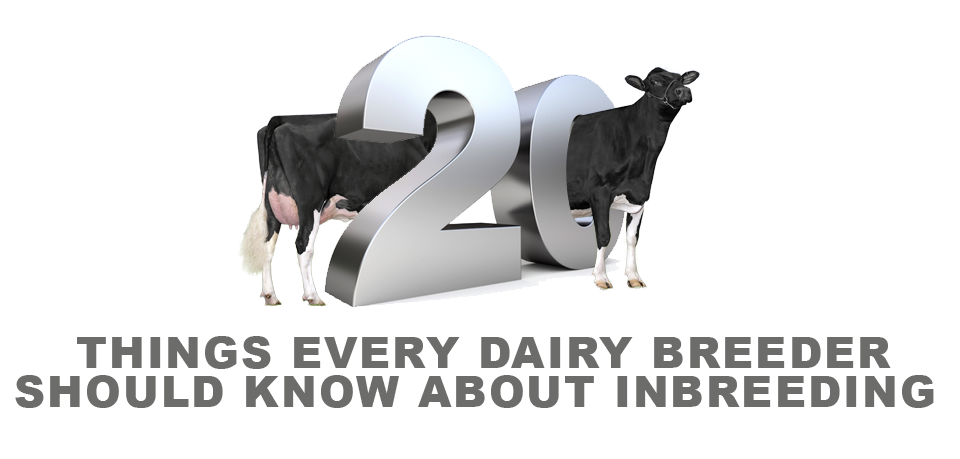When it works it’s called line breeding, when it doesn’t it could be a disaster. Here are 20 things every dairy breeder should know about inbreeding.
How does it happen?
1. Inbreeding results from the mating of related individuals.
2. Relationships between dairy animals are increasing over time because of selection toward similar breeding objectives.
Five possible reasons you can tell yourself not to be concerned about inbreeding
3. Outstanding bulls should be used if the benefits of genetic improvement exceed losses from any possible inbreeding depression
4. Inbreeding has played a role in development and improvement of specialized strains of livestock.
5. The positive aspect of inbreeding is that the genotypes of sperm or egg cells from inbred individuals are more predictable than for outbreds.
6. If the inbred animal were superior and transmitted its superiority with regularity, the advantages would be obvious.
7. Inbreeding can also be used to “purge” a line of cattle of undesirable recessive genes.
Ten realistic reasons to be concerned about inbreeding
8. Inbreeding is expensive. For cows that survive to freshen the first time, each 1% increase in inbreeding reduces lifetime net income by $22 to $24.
9. There is no magic level of inbreeding that is acceptable. Effects of inbreeding on performance of commercial dairy cattle are almost entirely negative.
10. Inbreeding decreases performance. Inbreeding decreases cow survival, single lactation production and reproductive performance.
11. Inbreeding increases negative factors. Inbreeding increases calf mortality, increases age at puberty through retarded growth, and increases rate of disposal or loss of replacement heifers prior to first calving.
12. Inbreeding should be managed in herd breeding programs rather than avoided.
13. Inbreeding in offspring differs for each sire-dam combination, making mate assignments important if inbreeding is to be managed properly.
14. Blanket recommendations of a bull as an “outcross” to groups of cows may not be effective in reducing the impact of inbreeding.
15. The development of large, specialized dairies in North America in recent years has been accompanied by decreased emphasis on individual animal identification.
16. Many large herd managers have questioned the benefits of individual cow ID to their operation. Avoidance of inbreeding losses is one such benefit.
17. When undesirable recessive genes appear in the homozygous state (bb), the condition is often fatal.
Two Thoughts to Take Away
18. Optimum methods to control inbreeding will choose the sire with highest genetic merit adjusted for inbreeding in a specific mating rather than avoiding some maximum level in inbreeding.
19. Complete, accurate pedigree data for cows to be mated and sires used as mates will be a necessary part of such mating decisions.
THE BULLVINE BOTTOM LINE
20. Losses due to inbreeding can be minimized through careful attention to accurate records. If we can’t estimate inbreeding in a mating because of limited pedigree data, we cannot avoid inbreeding or estimate its costs.
For more information check out The Bullvine Bull Book or our Genetic Evaluation Resource Center.
















Hi,
Great article about inbreeding, but it looks like you might miss one important point that many commercial dairymen have chosen today to stop inbreeding and use the opposite effect (heterosis) : dairy crossbreeding.
and crossbreeding should not be seen anymore as a bad word. For crossbreeding, purebred sires are needed to generate commercial crossbred cows. Purebreeders are still needed for this purpose.
http://dairyxbred.com/
This blog will tell how this option is growing among commercial dairymen.
Thank you
Stephan